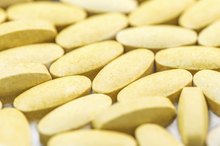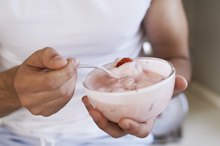What does fact checked mean?
At Healthfully, we strive to deliver objective content that is accurate and up-to-date. Our team periodically reviews articles in order to ensure content quality. The sources cited below consist of evidence from peer-reviewed journals, prominent medical organizations, academic associations, and government data.
- “mBio”; Adequate Vitamin D during Pregnancy Reduces the Risk of Premature Birth by Reducing Placental Colonization by Bacterial Vaginosis Species; William B. Grant; March 2011
- “mBio”; Adequate Vitamin D during Pregnancy Reduces the Risk of Premature Birth by Reducing Placental Colonization by Bacterial Vaginosis Species; William B. Grant; March 2011
- “The Journal of Nutrition”; Maternal Vitamin D Deficiency Is Associated with Bacterial Vaginosis in the First Trimester of Pregnancy; Lisa M. Bodnar, et al.; June 2009
- “The Journal of Nutrition”; Maternal Vitamin D Deficiency Is Associated with Bacterial Vaginosis in the First Trimester of Pregnancy; Lisa M. Bodnar, et al.; June 2009
- “The Journal of Nutrition”; Dietary Intake of Selected Nutrients Affects Bacterial Vaginosis in Women; Yasmin H. Neggers, et al.; September 2007
- “The Journal of Nutrition”; Dietary Intake of Selected Nutrients Affects Bacterial Vaginosis in Women; Yasmin H. Neggers, et al.; September 2007
The information contained on this site is for informational purposes only, and should not be used as a substitute for the advice of a professional health care provider. Please check with the appropriate physician regarding health questions and concerns. Although we strive to deliver accurate and up-to-date information, no guarantee to that effect is made.
Vitamins That Help BV Infections
Bacterial vaginosis, also known as BV, is an infection that occurs in the lining of the vagina. Symptoms of bacterial vaginosis include a foul odor, heavy discharge, clear to gray discharge color and red and swollen vaginal membranes. However, some women with bacterial vaginosis may have no symptoms. Bacterial vaginosis is caused by an overgrowth of bacteria and fungus in the vagina due to vitamin deficiencies, improper nutrition, hormonal imbalances, pregnancy, stress and a plethora of other factors 2. Eating a diet rich in vitamins C, B, D and E can aid in preventing the occurrence of this uncomfortable infection.
If you are experiencing serious medical symptoms, seek emergency treatment immediately.
Vitamin C
Vitamin C, a powerful antioxidant, strengthens your immune system and protects the lining of your vagina from the overgrowth of bacteria. According to the University of Maryland Medical Center, take a 500 mg supplement of vitamin C twice per day or enrich your diet with foods high in vitamin C. Fruits high in vitamin C and other antioxidants include cherries, blueberries and tomatoes. The seed of a grapefruit, also a fruit high in vitamin C, contains antibacterial and antifungal properties boosting immune functioning.
Folate
Causes of Gardnerella Infection
Learn More
High intake of folate is associated with lower risk of developing severe bacterial vaginosis, according to a 2009 study published in “The Journal of Nutrition.” Folate is linked with a decreased risk of cancer and is thought to enhance immune functioning, which may aid in prohibiting the growth of bacteria 2. Folate also aids the blood in distributing oxygen to the cells, ensuring adequate cell function. Foods high in folate and other B vitamins include almonds, whole grains, spinach, kale and beans.
Vitamin D3
Bacterial vaginosis is associated with increased risk factors among pregnant women, such as preterm birth and a surplus of harmful bacteria in the vagina 2. Vitamin D deficiency may increase a pregnant woman’s chance of developing bacterial vaginosis 2. African American women are particularly susceptible to developing this infection due to the amount of melanin in their skin, which prevents the skin from absorbing the sunlight needed for vitamin D production. Vitamin D decreases the development of bacterial vaginosis by producing natural antibodies that fight bacteria, fungus and viruses. According to a 2011 article published by the American Society for Microbiology, pregnant women may require supplementation up to 6,400 IU of vitamin D3 per day. Other sources of Vitamin D include direct sunlight exposure and foods rich in fish oil, like salmon and mackerel.
- Bacterial vaginosis is associated with increased risk factors among pregnant women, such as preterm birth and a surplus of harmful bacteria in the vagina 2.
Vitamin E
Natural Herbal Treatments and Vitamins for Cervical Cancer
Learn More
Vitamin E consumption decreases a woman’s chance of generating an overgrowth of bacteria leading to bacterial vaginosis, as reported by a 2011 study published in “The Journal of Nutrition.” Vitamin E is a potent antioxidant and increases the body’s immune response. Vitamin E supplementation decreases infection rates and respiratory problems observed among older individuals. Increased immune response and bacteria-fighting antioxidants regulate bacteria levels in the vagina. Rich sources of vitamin E include:
- wheat germ
- sunflower seeds
- almonds
- peanut butter
- broccoli
- tomatoes
- Vitamin E consumption decreases a woman’s chance of generating an overgrowth of bacteria leading to bacterial vaginosis, as reported by a 2011 study published in “The Journal of Nutrition.”
Related Articles
References
- “mBio”; Adequate Vitamin D during Pregnancy Reduces the Risk of Premature Birth by Reducing Placental Colonization by Bacterial Vaginosis Species; William B. Grant; March 2011
- “The Journal of Nutrition”; Maternal Vitamin D Deficiency Is Associated with Bacterial Vaginosis in the First Trimester of Pregnancy; Lisa M. Bodnar, et al.; June 2009
- “The Journal of Nutrition”; Dietary Intake of Selected Nutrients Affects Bacterial Vaginosis in Women; Yasmin H. Neggers, et al.; September 2007
- Reiter S, Kellogg spadt S. Bacterial vaginosis: a primer for clinicians. Postgrad Med. 2019;131(1):8-18.
- Bilardi J, Walker S, McNair R, et al. Women's Management of Recurrent Bacterial Vaginosis and Experiences of Clinical Care: A Qualitative Study. PLoS One. 2016;11(3):e0151794. Published 2016 Mar 24. doi:10.1371/journal.pone.0151794
- Koumans EH, Sternberg M, Bruce C, et al. The prevalence of bacterial vaginosis in the United States, 2001-2004; associations with symptoms, sexual behaviors, and reproductive health. Sex Transm Dis. 2007;34(11):864-9.
- Kumar N, Behera B, Sagiri SS, Pal K, Ray SS, Roy S. Bacterial vaginosis: Etiology and modalities of treatment-A brief note. J Pharm Bioallied Sci. 2011;3(4):496–503. doi:10.4103/0975-7406.90102
- McDonald HM, Brocklehurst P, Gordon A. Antibiotics for treating bacterial vaginosis in pregnancy. Cochrane Database Syst Rev. 2007;(1):CD000262. Published 2007 Jan 24. doi:10.1002/14651858.CD000262.pub3
- Kairys N, Garg M. Bacterial Vaginosis. [Updated 2019 May 4]. In: StatPearls [Internet]. Treasure Island (FL): StatPearls Publishing; 2019 Jan-. Available from: https://www.ncbi.nlm.nih.gov/books/NBK459216/
- Kumar N, Behera B, Sagiri SS, Pal K, Ray SS, Roy S. Bacterial vaginosis: Etiology and modalities of treatment-A brief note. J Pharm Bioallied Sci. 2011;3(4):496–503. doi:10.4103/0975-7406.90102
- Muzny CA, Schwebke JR. Pathogenesis of Bacterial Vaginosis: Discussion of Current Hypotheses. J Infect Dis. 2016;214 Suppl 1(Suppl 1):S1–S5. doi:10.1093/infdis/jiw121
- Mackelprang RD, Scoville CW, Cohen CR, et al. Toll-like receptor gene variants and bacterial vaginosis among HIV-1 infected and uninfected African women. Genes Immun. 2015;16(5):362–365. doi:10.1038/gene.2015.13
- Money D. The laboratory diagnosis of bacterial vaginosis. Can J Infect Dis Med Microbiol. 2005;16(2):77–79. doi:10.1155/2005/230319
- Cook RL, Reid G, Pond DG, Schmitt CA, Sobel JD. Clue cells in bacterial vaginosis: immunofluorescent identification of the adherent gram-negative bacteria as Gardnerella vaginalis. J Infect Dis. 1989;160(3):490-6.
- Bradshaw CS, Sobel JD. Current Treatment of Bacterial Vaginosis-Limitations and Need for Innovation. J Infect Dis. 2016;214 Suppl 1(Suppl 1):S14–S20. doi:10.1093/infdis/jiw159
- Menard JP. Antibacterial treatment of bacterial vaginosis: current and emerging therapies. Int J Womens Health. 2011;3:295–305. doi:10.2147/IJWH.S23814
- Homayouni A, Bastani P, Ziyadi S, et al. Effects of probiotics on the recurrence of bacterial vaginosis: a review. J Low Genit Tract Dis. 2014;18(1):79-86.
- Muzny CA, Schwebke JR. Pathogenesis of Bacterial Vaginosis: Discussion of Current Hypotheses. J Infect Dis. 2016;214 Suppl 1(Suppl 1):S1–S5. doi:10.1093/infdis/jiw121
- Allworth, J. and Peipert, J. Severity of Bacterial Vaginosis and the Risk of Sexually Transmitted Infection.Am J Obstet Gynecol. 2011; 205(2):113.e1-113.e6. doi:10.1016/j.ajog.2011.02.060.
- Bagnall, P. and Rizzolo, D. Bacterial vaginosis: A practical review.J Am Acad Phys Assist. 2017; 30(12):15-21. doi:10.1097/01.JAA.0000526770.60197.fa.
- CDC. Bacterial Vaginosis (BV) Statistics: Bacterial vaginosis is the most common vaginal infection in women ages 15-44. Updated December 17, 2015.
- Centers for Disease Control and Prevention. 2015 Sexually Transmitted Diseases Treatment Guidelines: Bacterial Vaginosis. Atlanta, Georgia; updated June 4, 2015.
- Hainer, B. and Gibson, M. Vaginitis: Diagnosis and Treatment. Am Fam Physician. 2011; 83(7):807-815.
Writer Bio
Suzanne Allen has been writing since 2004, with work published in "Eating for Longevity" and "Journal of Health Psychology." She is a certified group wellness instructor and personal trainer. Allen holds a Bachelor of Arts in communication and information sciences, a Bachelor of Arts in psychology and a Master of Arts in clinical psychology.








